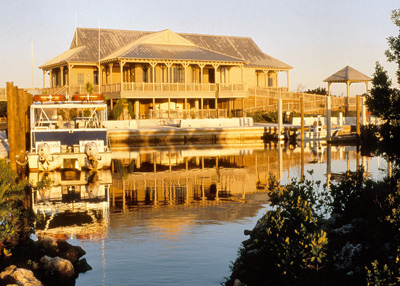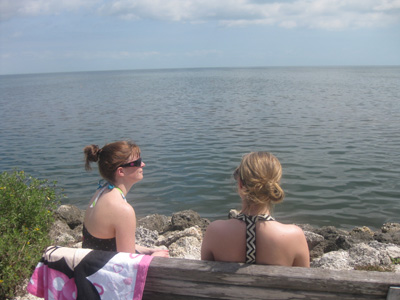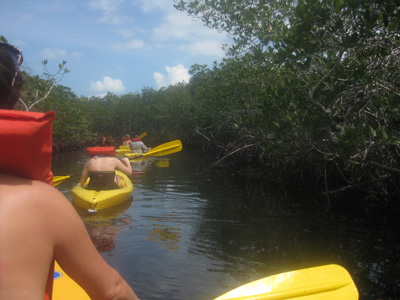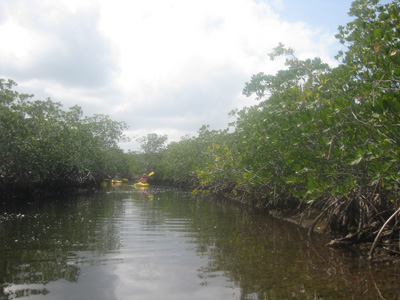
Visitors drawn to Biscayne’s manatees
HOMESTEAD, Fla.— Far off U.S. 1, past speedways and tarmacs and copycat housing developments, lies a quiet little patch of shoreline and islands known as Biscayne National Park.
The park covers 207 square miles, 95 percent water, of shoreline, islands and coral reefs. It is a safe haven for manatees, an endangered marine species that just suffered through an unusually cold South Florida winter — leaving up to 10 percent of the population dead.
 |
The Dante Fascell Visitor’s Center is the meeting and departure point at Biscayne National Park (Photo courtesy of the National Park Service). |
At Biscayne National Park, visitors take boats out to the nearby reefs to snorkel, go kayaking and paddle boating, and enjoy the quietness of the park. Many visitors are also drawn to the park in search of spotting a manatee.
When manatees and other animals are seen, visitors rush to a giant journal wildlife chart in the Dante Fascell Visitor’s Center and record their sightings.
“There’s a mother and a calf right here,” Supervisory Park Ranger Matt Johnson said. “And they’ve been seen since July, so they’ve been coming back quite often.”
The previous day, both mom and baby were spotted lolling right off of the coast. Within the last week, there had been over four manatee sightings.
British visitors Kat Maher, 23, and Claire Phillips, 24, came to Biscayne in search of the giant sea cows.
“I am going kayaking to look for a manatee,” Phillips said. “I think they’re amazing.”
| British tourists Claire Phillips and Kat Maher sit overlooking the bay at Biscayne National Park (Photo by Nina Markowitz). |  |
In Biscayne National Park, the best place to spot manatees is in the harbor just north of the Visitor’s Center. Or rent a kayak, canoe or paddle boat and go out into the bay in search of them. They might be massive creatures, but they are gentle giants.
“Manatees are the only mammals that don’t show any aggression towards any other creatures,” Johnson said. “They’re amazing and it’s really nice to see them.”
This does not mean you should touch or interact with them, however.
Despite the abundance of manatees in the park, the population as a whole is suffering.
“The population estimate of manatees is up,” Johnson said. “But they’re still living on the edge.”
 |
Kayakers in the park paddle while looking for manatees in the water below (Photo by Nina Markowitz). |
Johnson estimates the South Florida manatee population at 4,000 and rapidly shrinking. The shrinking was only expedited with the last winter, which proved too cold as one manatee carcass after another washed up on South Florida shores.
Dr. Vanessa McDonough is the park’s fishery and wildlife biologist.
“So far in 2010, there have been 383 reported manatee deaths in the state and 208 of those are cold stress related,” she said. “In the park, we were actually very fortunate and did not observe mortality due to cold stress.”
The Everglades had 90 deaths last winter alone. Even with such high death tolls related to the cold winter, McDonough remains optimistic.
“Everglades National Park had extensive mortality from the cold, [but] but there were no other cold-related deaths reported in Miami-Dade County.”
Despite approach of warmer weather, the manatees are still not completely safe.
Oftentimes too slow to avoid fast boats, manatees usually find themselves caught in propellers. This leads to injury and death.
When injured manatees are spotted by visitors, it is important that visitors get a good description of the animal and then report the sighting to Biscayne park staff.
| Kayakers head into the mangrove canals to look for manatees and other wildlife (Photo by Claire Phillips). |  |
Park staff then goes out to find the injured animal and assess the situation.
“[In] responding to injured or dead manatees, our protocol is to take GPS coordinates of the manatee’s location and to contact the Florida Fish and Wildlife Conservation Commission at their Miami-Dade dispatch office,” McDonough said.
In Biscayne National Park, where boating and other invasive recreational activities are permitted, Johnson admits it is a struggle to keep the animals safe.
“There is a manatee zone right outside of the park where people are required to go slow, but they don’t always obey the signs out there,” Johnson said.
Johnson recommends the Save the Manatee Fund for people hoping to get involved in manatee protection. But it’s also important for park visitors and boaters to let staff and other park attendees know when a manatee is spotted.
Walking across the Visitor Center porch to meet with fresh park arrivals, Johnson scans the harbor and smiles.
“Thanks for caring about manatees,” he said.
If You Go…
- Biscayne National Park is located off U.S. 1 and the Florida Turnpike Extension in Homestead, Fla.
- Boat rentals are available in the Gift Shop and range from $20 to $40.
- Manatees are often spotted at the boat basin and docking areas at park headquarters, Homestead Bayfront and Black Point marinas in winter months.
- http://www.savethemanatee.org provides information on what you can do to help save endangered manatees.

Comments are Closed